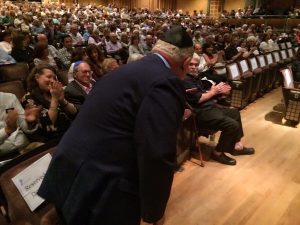Filmmaker Saul Henteleff went to unusual lengths to show authentic taharah practice in his newly released documentary on Jewish death and burial rites. He put himself on the table and underwent the ritual of washing and clothing his body.
“It was easy,” Henteleff says of lying on the table undergoing the rituals for cleansing the body and preparing it for Jewish burial. “There was no trauma. And it was a central part of the story.
“It would have been inappropriate to have filmed a real taharah. But since there are no rules against filming the process of taharah on a live volunteer, the Chesed Shel Emes board agreed to go ahead with this,” he said, referring to the community organization responsible for this process in Winnipeg.
More than 10 years in the making, Henteleff’s documentary, My Jewish Death debuted last month at the Berney Theatre (in the Asper Jewish Community Campus), as part of the Chesed Shel Emes annual appreciation evening for staff and volunteers. The event attracted more than 100 supporters.
In introducing the documentary, the filmmaker and high school film studies teacher noted that his journey into Jewish death and dying began with the funeral of Sheldon Oberman in 2004. Oberman was a popular teacher at the Gray Academy (Winnipeg’s Jewish day school), a nationally known storyteller and an author of children’s books and novels.
“The day of Obie’s funeral was a sad day [Oberman was only in his mid 50s] – but also a memorable one,” Henteleff said. “That day changed my life.
“Rabbi Neal Rose, in his eulogy, spoke about Obie’s soul still being with us in the sanctuary. I had never before heard any discussion about a Jewish spirit or Jewish afterlife.”
Henteleff’s quest to learn more about Jewish death and dying led him to the Chesed Shel Emes where, he said, he met a lot of wonderful people and became involved in the Chesed activities himself.
The half-hour documentary begins with Henteleff jogging while his voice-over introduces his spiritual quest. This is followed by scenes from a chevra kadisha cemetery conference in Portland, Ore., in 2007, which he attended.
The chevra kadisha are the men and women who perform the taharah rituals. In Winnipeg, taharahs are performed by a team of three volunteers for each body – with teams of women for female bodies and teams of men for male bodies. The process involves washing the body and clothing the body in simple white shrouds consisting of a top, bottoms, and a hood, prior to transferring the deceased into a coffin.
Most of the film shows Henteleff’s taharah as he is pulled from an enclosure, transferred to the table, cleansed, clothed, had soil from Israel applied to his eyelids and transferred to a coffin. We also watch as the pallbearers carry the coffin to the hearse for transport to the cemetery and the lowering of the coffin into the grave, where the viewer is looking up from inside the grave itself as the pallbearers shovel the earth on top of the coffin.
Throughout, there are breaks for commentaries from rabbis Neal Rose, Allan Green of Winnipeg’s Shaarey Zedek Congregation, and Ari Ellis, until a few months ago, the spiritual leader of the Adas-Yeshurun Herzlia Synagogue.
Henteleff singled out several people who were important contributors to the making of the documentary – in particular, Winnipeg-based Jewish composer Sid Robinovitch for his musical score.
The documentary was followed by a panel consisting of Henteleff, Chesed Shel Emes executive director Rena Boroditsky and Rabbi Green fielding questions from the audience.
Among the questions were ones about embalming and the use of chemicals to preserve the body (none are used in Jewish burials), whether or not a coffin is a religious requirement (no) and how the chevra kadisha works with a damaged body. (“We do the best we can,” Boroditsky said.)
One questioner asked Henteleff how the ritual speaks to secular people. His response was that everyone can appreciate on a human level the feeling of being cared for.
When asked if his film students are going to see the documentary, he noted that he expected some of them to be at the screening at Cinematheque after the film’s debut last month.
No further screenings are currently planned.








